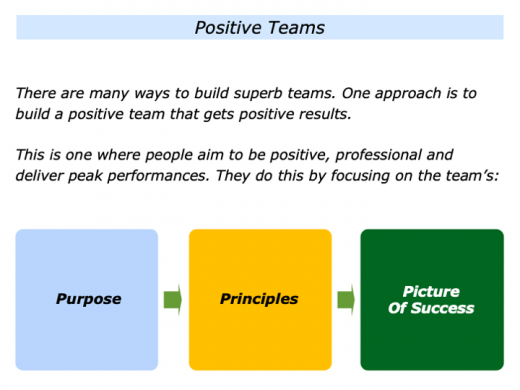
How can you continue to build superb teams? This article describes one approach. It is based on a model that I have seen work in many fields during the past fifty years.
Although here it is called Positive Teams, the organisations I have used it with have branded it in different ways. They have called it Super Teams, Peak Performing Teams or other names.
Whatever the name, however, the principles remain similar. They are based on what works and – providing people do the work – it works.
This piece on teams is long because it includes many models and tools you can use to build such teams. You can then use these in your own way. Let’s explore these themes for building such teams.
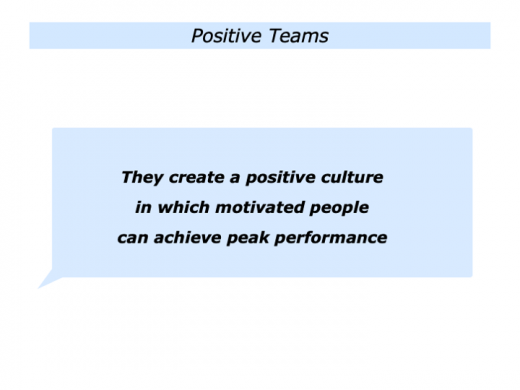
Setting The Scene
Good leaders start by creating a positive environment in which motivated people can achieve peak performance. They sometimes take the following steps towards making this happen.
Such leaders make sure that everybody understands the team’s purpose, principles and picture of success. They do this because they believe that people work best when they have context and can see the big picture.
They then give people the chance to reflect and decide if they want to contribute. If so, they encourage people to build on their strengths and clarify their best contributions.
Positive teams are made up of people who aim to be positive, professional and peak performers. They also want to do superb work and do their best to help the team to succeed.
Good leaders make clear contracts with people about the results they will deliver towards achieving the goals. They also give people the support they need to deliver the goods.
They then manage by outcomes rather than by tasks. They encourage people to co-ordinate their strengths, perform superb work and find solutions to challenges. People then do whatever is required to achieve the picture of success.
Imagine that you are leading a team that is about take the next step in its development. You will have your own framework for making this happen.
If you wish, however, you can use the following approach for enabling people to achieve peak performance. The following pages describe the specific things you can do:
To clarify and communicate the team’s purpose, principles and picture of success;
To make clear contracts with people about their best contributions towards achieving the picture of success;
To enable people to perform superb work and do their best to achieve the picture of success.
Clarifying The
Team’s Purpose
There are many ways for a person or team to begin clarifying their purpose. Here are some of the common approaches.
People focus on something they want to serve – such as a set of values, vocation or mission – that is greater than themselves.
People focus on the things they feel passionately about in which they can also achieve peak performance.
People focus on how they can build on their strengths and do superb work that helps all their stakeholders to achieve success.
Some people combine all of these approaches. They then translate their findings into a compelling purpose.
Many start by building on their strengths. This involves them taking the following steps.
They clarify their strengths – the deeply satisfying activities in which they deliver As rather than Bs or Cs.
They clarify the specific kinds of people – customers, clients and other stakeholders – with whom they work best and the challenges these people face.
They clarify how they can use their strengths to do satisfying work and help these people to achieve success.
Building on what they have discovered, they then do an exercise that involves them beginning to clarify their purpose.
Imagine that you want to take this step. Imagine also that you and your colleagues have already done some work on clarifying the team’s strengths.
You can then invite them to build on the team’s strengths and define the specific thing that the team really wants to do. Here is one approach you can take to begin the process.
Invite each person to complete the following sentence. They can write their ideas on Post-its.
Purpose
The purpose of our team – the
specific thing we really want to do – is:
“We want to …
You can also invite people to give some examples of what this might look like in practice. They can write these examples on separate Post-its.
People can put their ideas on flip charts that are headed in the following ways. They can also explain what they have written on the Post-its.
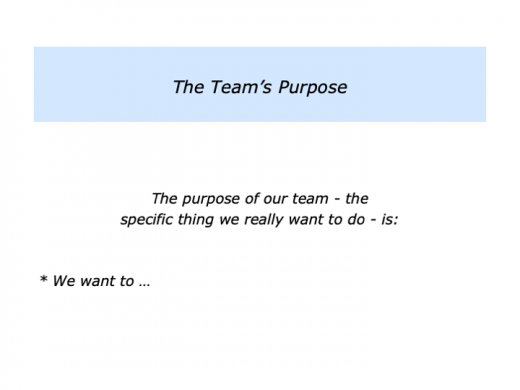
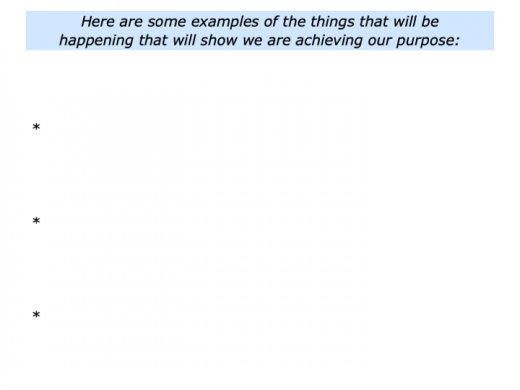
Imagine that you have done this exercise with your colleagues in the leadership team. It can then be useful:
To build on the points people have in common;
To take time to reflect and then have a first go at clarifying the team’s purpose;
To use this as the basis for focusing on the principles and picture of success – but also being prepared to return to the one liner and recraft it if you wish.
There is one key point worth bearing in mind when doing this exercise. Some people may want to get into a discussion about the difference between a purpose, mission and vision.
Different people interpret these words in different ways, so try to avoid getting into a long discussion about semantics.
One view is that a team’s purpose describes the specific thing people feel really driven to do. They then translate this into specific goals that they want to achieve by a certain date. This then becomes the team’s vision or picture of success.
Some organisations prefer to use the word mission. A military mission, for example, must have achievable objectives. It must also be time based and, if appropriate, have a clear exit strategy. Military people then know what they must achieve by a certain date.
Susan Ward studied many organisations that took this approach. Here is her definition of a mission statement.
A mission statement is a brief description of a company’s fundamental purpose. It answers the question, “Why does our business exist?”
The mission statement articulates the company’s purpose both for those in the organization and for the public. For example: “Tesla’s mission is to accelerate the world’s transition to sustainable energy.”
Imagine you have focused on the team’s purpose. The theme you have come up with may need some wordsmithing, which you can do later. It can be useful, however, to move on to the next step.
Clarifying The
Team’s Principles
The next step is to define the principles – the guidelines – you would like people to follow to achieve the purpose. There are many ways to define these principles.
One approach is to simply invite people to describe the Dos and Don’ts that everybody in the team can follow to work towards achieving the goals.
If you wish, you can invite people to take this step by them writing what they believe are the Dos and Don’ts on Post it Notes. They can then put these on flip charts under these respective headings.
The key thing about principles are that these describe the guidelines people can follow to increase the chances of achieving the goals. These are driven by the team’s purpose rather than by the whim of the leader.
Here is a list of the Dos that one organisation communicates to people when they join. They describe these as their professional guidelines and use real examples to bring these to life.
Principles
The principles we would like people to follow
to work towards achieving our goals are:
Do be positive and encourage other people;
Do be clear on the organisation’s goals and your part in contributing towards achieving these goals;
Do make clear contracts with people and fulfil these contracts;
Do focus on outcomes – the real results to achieve in a situation – and do your best to achieve these outcomes;
Do behave professionally, present solutions to challenges and help both colleagues and clients to succeed.
You will have your own set of Dos and, if appropriate, Don’ts. It is also important to be able to give the reasons for each of the principles. When communicating these, you can say:
The first principle we would like people to follow to
increase the team’s chances of achieving success is:
*
The reasons why it is important
to follow this principle are:
*
*
*
This helps people to understand the team’s purpose and also why it is important to follow certain principles to reach the goals. If you wish, you can invite people in the leadership team to complete the following exercise.
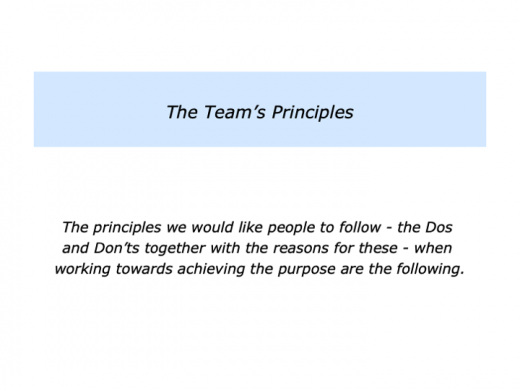


Clarifying The Team’s
Picture Of Success
Imagine that you and the leadership team are reasonably happy about the team’s purpose and principles. You can then translate these into specific goals to achieve by a certain date. These goals will then become the team’s picture of success.
There are many frameworks you can use to take this step. One approach is to see it as clarifying the team’s story, strategy and road to success.
This involves focusing on the What, Why, How, Who and When. It involves you using the following headings.
The What
The specific goals we want to achieve are …
The Why
The specific benefits of achieving these goals will be …
The How
The specific strategies we aim to follow to achieve the goals are …
The Who
The specific responsibilities of the various people in working towards achieving the goals will be …
The When
The specific things that will be happening – and when – along the road towards achieving the goals will be …
Several points are worth bearing in mind when writing the team’s road to success.
You can choose your own time frame.
Different teams choose different time frames. You may want to pick a date one year, two years or three years in the future.
Start by settling on your chosen date. Describe the specific things you want the team to have achieved by that date. This becomes your picture of success.
You can be clear on the mandatory things the team must deliver to achieve success.
The team will be expected to deliver its scorecard – the specific targets it must deliver – over the financial year. You can add other things on top of this – such as stimulating projects and successes – that will enrich the team’s story.
You can clarify for whom you are writing the presentation.
You may initially write it for your employees. This will ensure everybody knows the team’s goal. Later you can adapt the presentation – whilst staying true to its spirit – so that it resonates with other key stakeholders.
You can write the presentation by yourself or, if you wish, involve other key people at various stages.
This will give people a sense of ownership in terms of shaping the future.
Choosing A Template
Different teams use different templates for framing their goals. Many leaders in companies focus on the three Ps when clarifying their aims.
They focus on the Profits, Products – including Customer Satisfaction – and People. These are, of course, interrelated. For example:
Profits – the profitability they want to deliver;
Products – the product quality, customer satisfaction and processes they want to deliver;
People – the culture they want to deliver.
Here is one approach you can use to craft the picture of success.
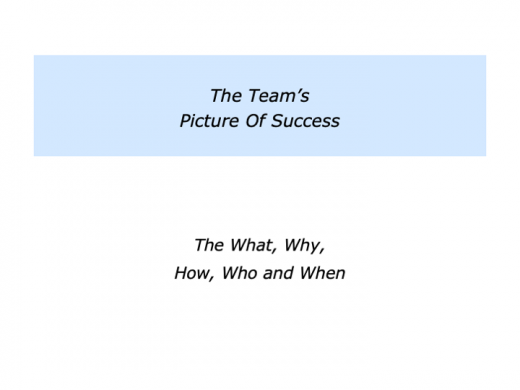
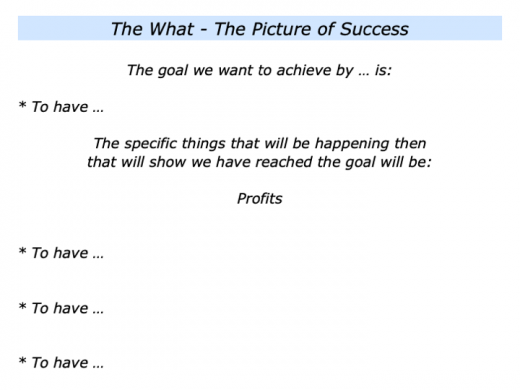

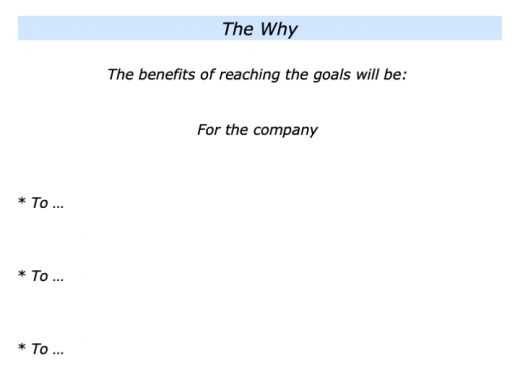
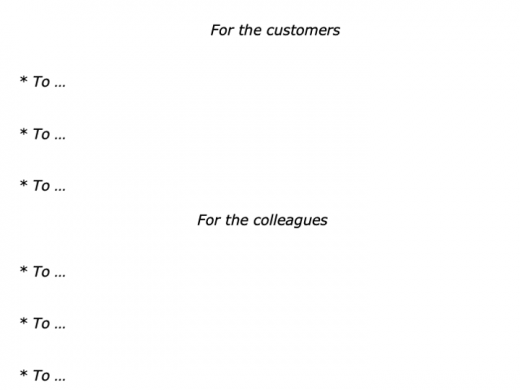
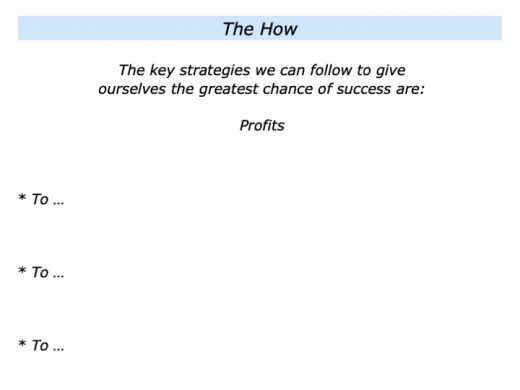

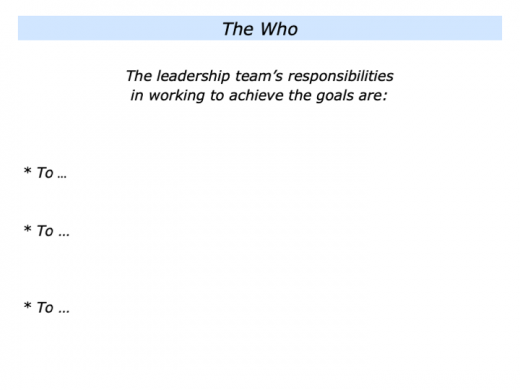
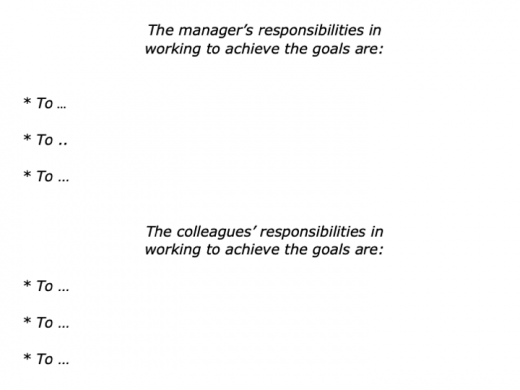
Clarifying
The Road Map
The road map is the When part of the story. This will become the team’s ongoing working document. Several things are worth remembering when making the road map.
Start from the destination and work backwards.
Start by picking a date in the future. Describe the specific goal you want the team to achieve by that date. Also describe the specific things that will be happening then that will show you have achieved the goal.
Dating the road map.
Start at the top of the Dates column and put the end date. Then work backwards towards the present day. You may want to break up the road map into quarters or other suitable periods.
This starting from the destination approach is used on many successful projects. It encourages people to keep focusing on the end goal.
Choose a suitable template for chunking the goals.
Here we have used the Three Ps framework – Profits, Products – including customer satisfaction – and People. You may prefer to use another template.
Describe the cumulative targets.
The totals under each heading for each quarter should be cumulative. This is illustrated below with Profits, but do it with each heading. For example:
Q4. Profits £1 million
Q3. Profits £750k
Q2. Profits £500k
Q1. Profits £250k
This describes the headline under Profits, but this could be broken down into more detail. You might want to consider having three bullet points of deliverables under each of Profits, Products and People. This helps to flesh out the road map
Bring the road map to life with quotations.
Describe the actual words you would like to hear people saying at various stages of the journey. These can be quotes from leaders, customers, colleagues or whoever.
Here is the framework for the road map. This describes the specific things the team needs to have delivered by the end of each quarter over one year. You can use a longer or shorter time frame for the road map.
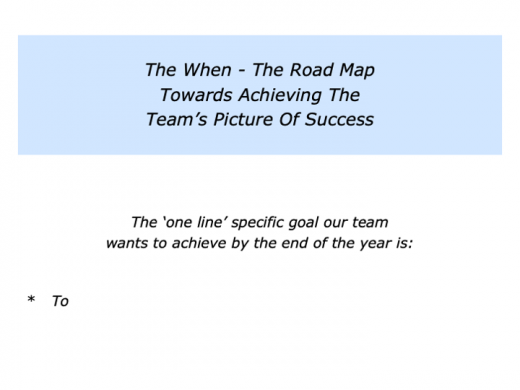
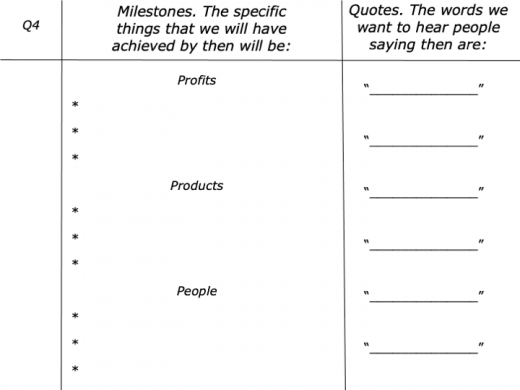
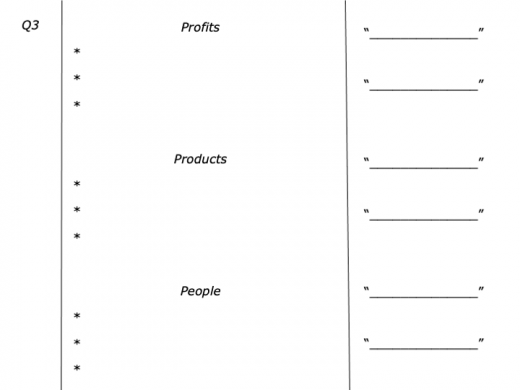
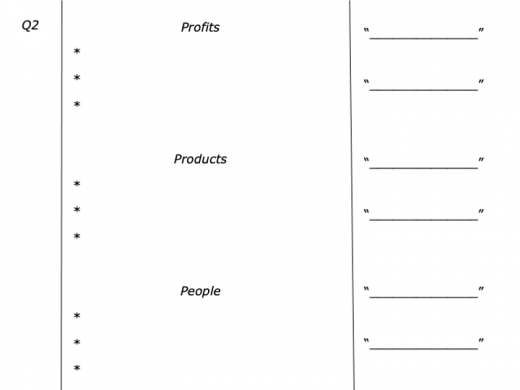
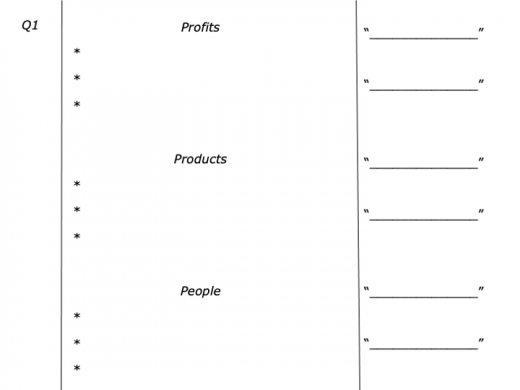
Communicating The
Picture Of Success
Imagine you want share this with the whole team. If this is the first time you have described the purpose and principles to your people, then it will be important to spend some time on these.
What you may find, however, is that people may simply see these as confirmation about the overall direction. They may be more concerned with their specific goals for the next year.
If you feel it is appropriate, you can give people further background about the purpose and principles. It will be important to explain the reasoning and bring the ideas to life by giving concrete examples.
You can then share the picture of success. Describe and bring to life the What, Why, How and Who, because this provides the overall direction for the team.
You can also give people a brief overview of the team’s road map – the When. This can be explored in greater depth, however, after people know the team’s direction and picture of success.
You may want to gather people together and say something along the following lines. You can supplement this with attractive slides that bring the ideas to life.
The Team’s Purpose,
Principles And Picture Of Success
Welcome to the session. Today we would like to look at how the team can continue to achieve ongoing success.
The Purpose
As you may know, the team’s purpose is:
*
The Principles
As you may also know, the principles we encourage people to follow to work towards achieving the team’s purpose are:
*
*
*
The Picture Of Success
Looking ahead, there are certain goals we want to achieve in the next year. We have translated these into a provisional picture of success. Before describing this, we want to give you some context.
We want to explain the possible strategies we have considered for going forwards. We will then describe the strategy we have chosen to follow and the reasons for pursuing this route.
Bearing in mind the various challenges we face, there are many different routes the team can take towards achieving its goals. Here is an overview of some of the possible routes we could take in the future.
Option A would be to …
The pluses and minuses of this route would be …
Option B would be to …
The pluses and minuses of this route would be …
Option C would be to …
The pluses and minuses of this route would be …
Option D would be to …
The pluses and minuses of this route would be …
Option E would be to …
The pluses and minuses of this route would be …
Bearing these options in mind, we have chosen to take the following route …
The reasons we have chosen this route are because …
There are, of course, pluses and minuses involved in pursuing this route.
The specific things we can do to build on the pluses and minimise the minuses are …
We have therefore put together the following picture of success.
Later we will describe the potential road map. We will then want your input regarding the action plan.
You can then go through the slides that describe The Picture Of Success.
Getting Responses To
The Picture Of Success
Imagine you have communicated the purpose, principles and picture of success. Again, if this is the first time you have communicated the team’s purpose and principles, it will be good to get people’s responses to these themes.
Imagine, however, that people are already generally aware of these. It can then be useful to explain that, whilst you are happy to answer questions about the purpose and the principles, you mainly want their views on the picture of success.
How to get good quality responses from people? Instead of simply asking for questions, you can take the following steps to stimulate and involve the team.
Invite people to form groups. There is to be a scribe in each group. Ask people to give their responses under the following headings.
Give people at least 30 minutes to do the exercise. Each group’s ideas can be written on flip charts as they go along.
If you are the leader – or if there is a leadership team that has introduced the strategy – you can give people twenty minutes to get started. You can then go around and look at the themes that are emerging.
This helps you to prepare to address the themes and answer any questions. (You will have told people beforehand that you will be going around to see the themes that emerging.)
The next step is to invite people to report back. It can be useful to cluster the themes and questions that emerge. You can then respond and answer more effectively. When answering questions, explain the following guidelines to people.
You will aim be honest and answer as fully as possible. You will do this because you want people to understand the strategy, the rationale behind it and the steps going forwards.
You will focus on the overall strategic issues when answering the questions. You will not be able to say exactly what each person in each job will be doing in a few months.
You will set aside time over the next week to meet individuals and answer, their questions. They can book a time to see you.
You may not be able to answer all the questions in the session. You will be able to get back with some answers. There may also be questions that, because of certain issues, you will choose not to answer.
You will also take away the ideas and see which of these can be added to the strategy.
Bearing these things in mind, you can embark on addressing the themes and questions that have emerged.
Good leaders often see these sessions as an opportunity to educate people about the strategy. People go away with a wider grasp of the issues. They are then more able to explain the strategy to new people who join the team.
Here are the exercises you can give to the team members to get their responses to the presentation.
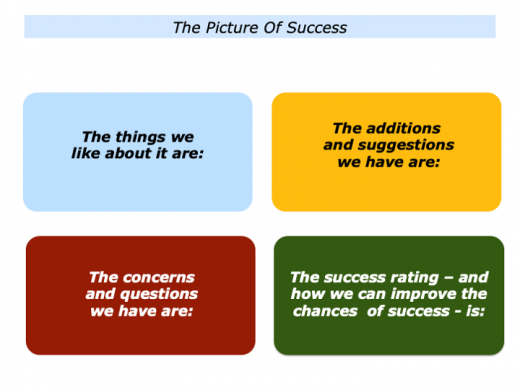



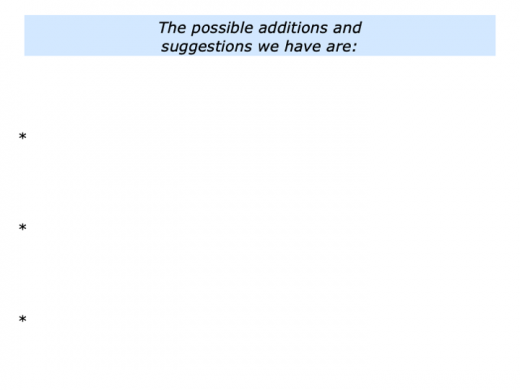

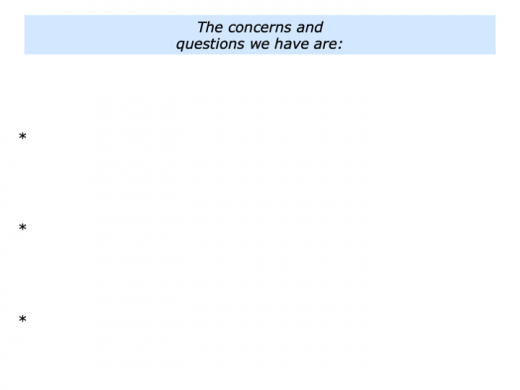
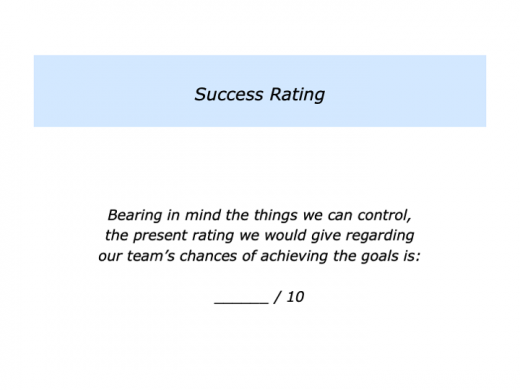
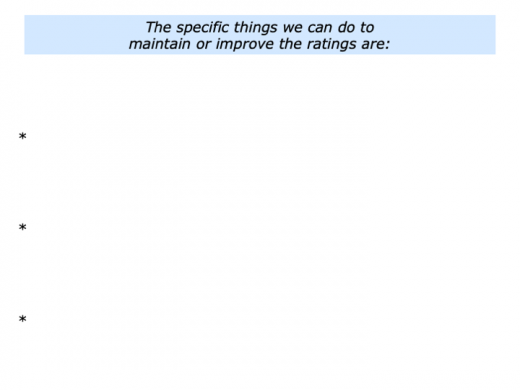
Clarifying Everybody’s Contribution
Towards Achieving The Picture of Success
Good leaders aim to build a culture in which people can thrive. They also recognise, however, that great teams are made up of people who have similarity of spirit and diversity of strengths. Diversity of spirit is a recipe for disaster.
Such leaders create teams that are made up of people who aim to be positive, professional and peak performers. They then invite these people to make their best contributions towards achieving the picture of success. They take the following steps to make this happen.
They communicate the purpose, principles and picture of success.
They give people a chance to reflect and decide if they want to opt into achieving the goals.
They invite people – the smaller teams within the larger team and the individuals within those teams – to make clear contracts about their best contributions towards achieving the goals.
Good leaders manage by outcomes rather than by tasks, so you may wish to take the following steps:
To, if appropriate, ask each smaller team within the team to produce its road map towards delivering its contribution towards achieving the overall picture of success;
To pick a date – perhaps three weeks in the future – when the whole team will gather and each smaller team will present its road map;
To then set a date by which each individual will have made clear contracts about the contribution to achieving the picture of success;
To make sure that these contracts are written in outcome terms – the specific things people are going to deliver under the headings of profits, products and people;
To tell people that, after the contracts are agreed, everybody will gather each month to report their progress on the road towards achieving the picture of success.
Imagine that you have clarified each small team’s contributions. People can then clarify the outcomes they will personally deliver towards achieving these goals.
There are many frameworks you can use to help people to clarify their individual contributions. Here is one approach that can be used.
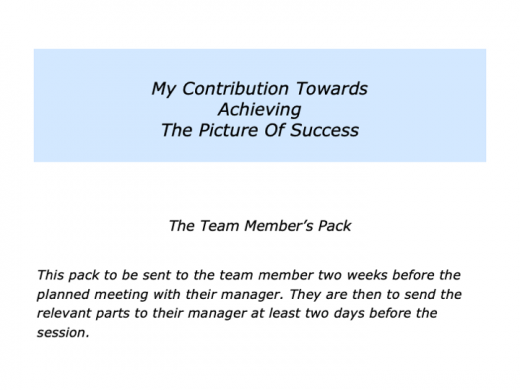
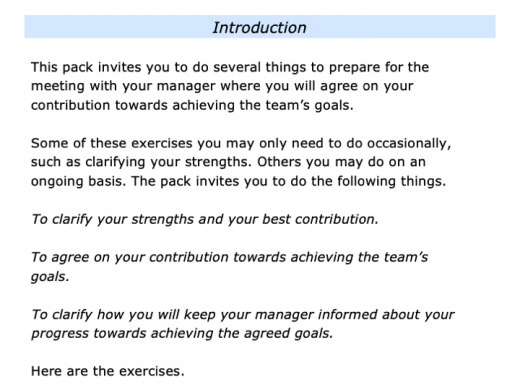

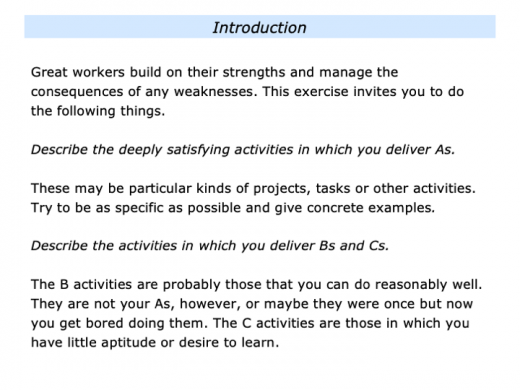
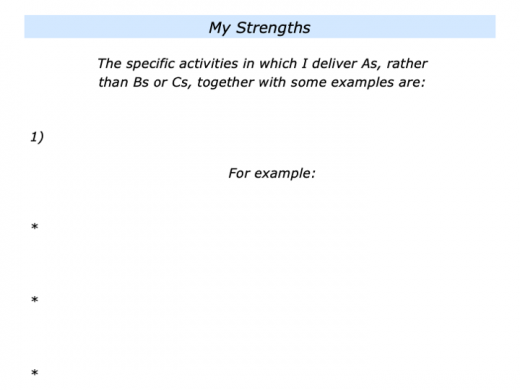


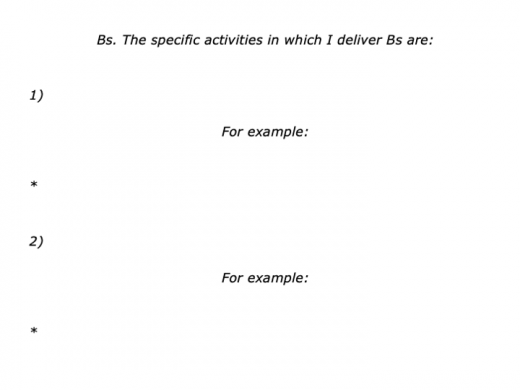
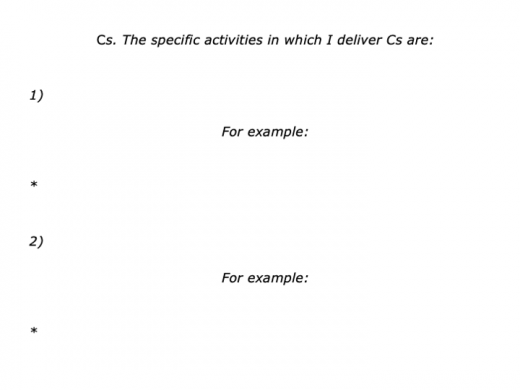
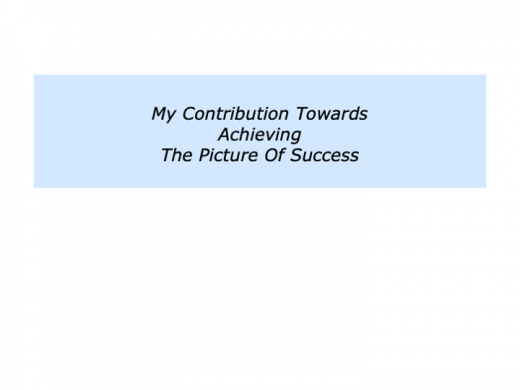
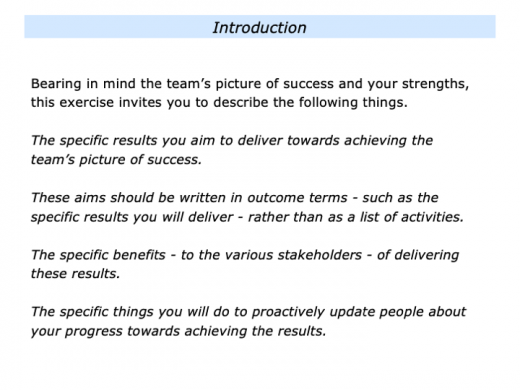
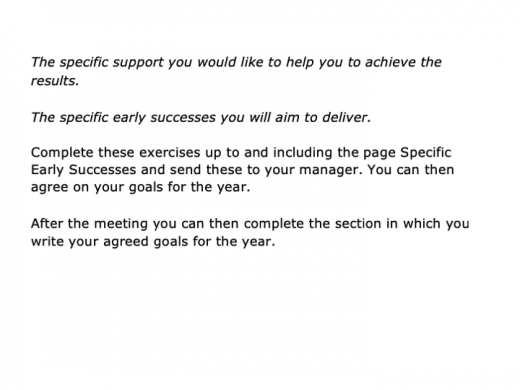
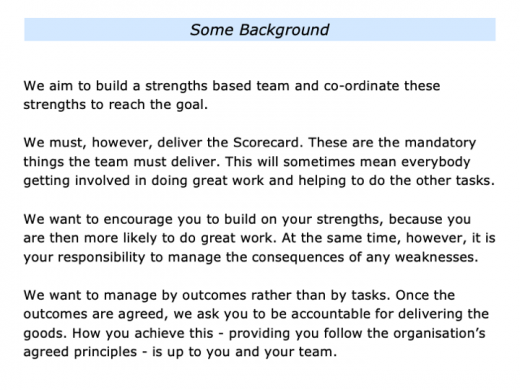
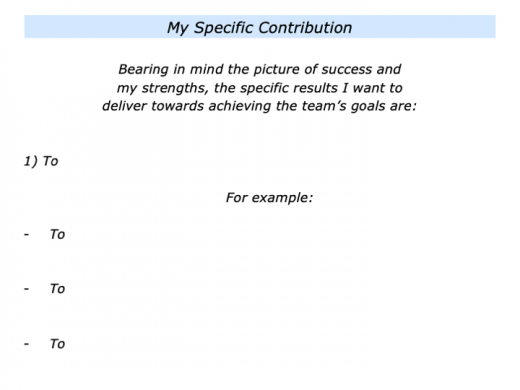


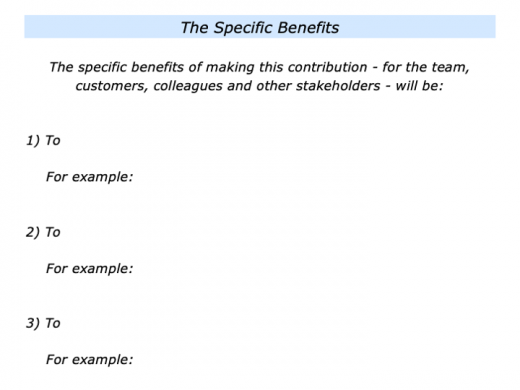
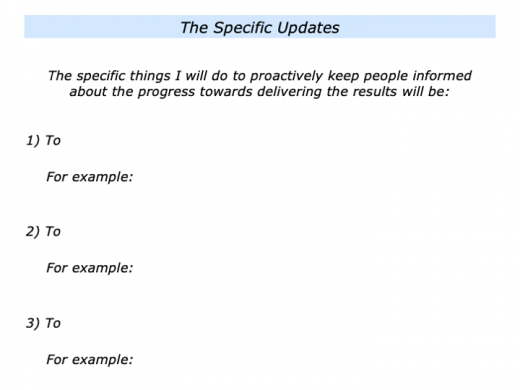

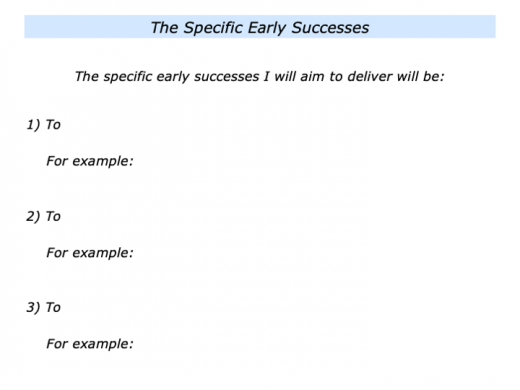

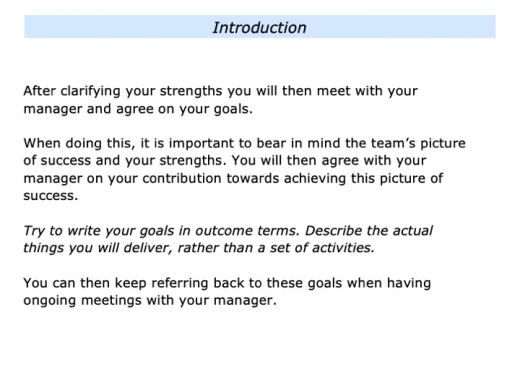
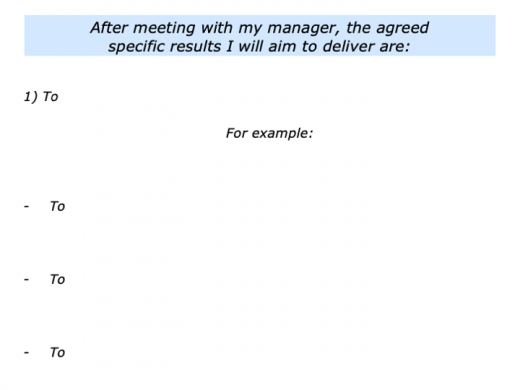


Good organisations ensure that everybody knows the overall goals. Each team and each person then makes clear contracts about their contributions towards achieving the aims. So the overall picture may look something like the following.
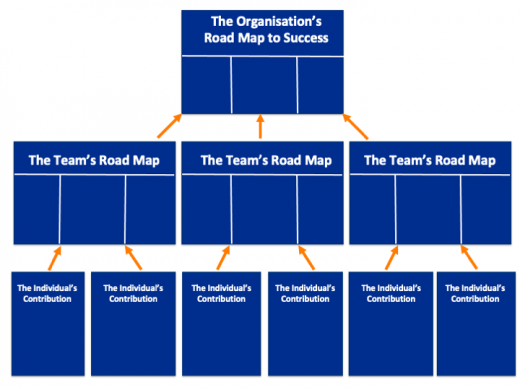
Continuing To Focus On
The Picture Of Success
Good leaders encourage people to keep doing the right things in the right way every day. The road map may evolve, of course, but it is vital to keep people focusing on the goals.
Imagine that you have gone through the stages mentioned earlier. You can then encourage people:
To perform superb work;
To proactively report on their progress towards achieving the goals – this also involves producing and publicising success stories;
To find positive solutions to challenges and achieve the picture of success.
Good leaders enable people to take these steps. They also ensure that people keep reporting their progress towards achieving the goals.
One approach to doing this is to meet with each person on a regular basis. Here is one framework that they can follow for reporting the progress they have made and their plans for the future. They can then share this with you, for example, every month or another time frame.

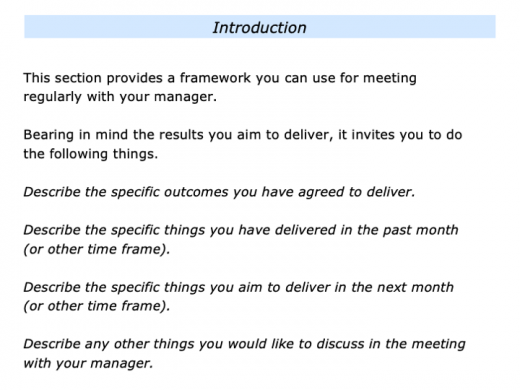
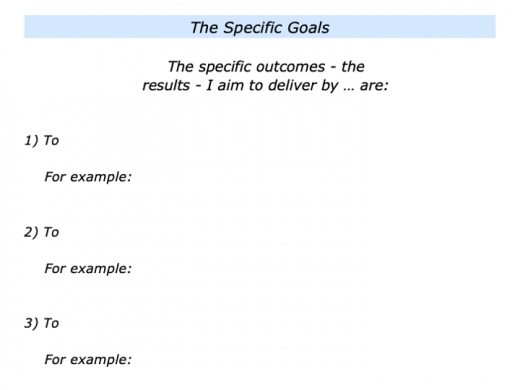
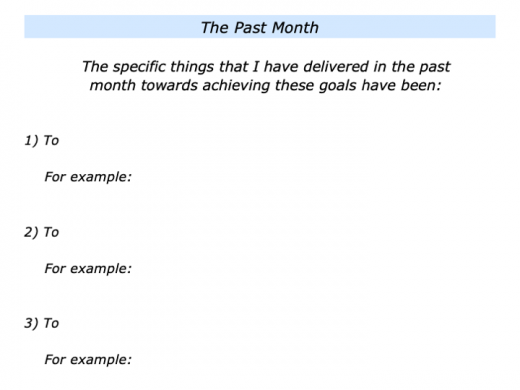
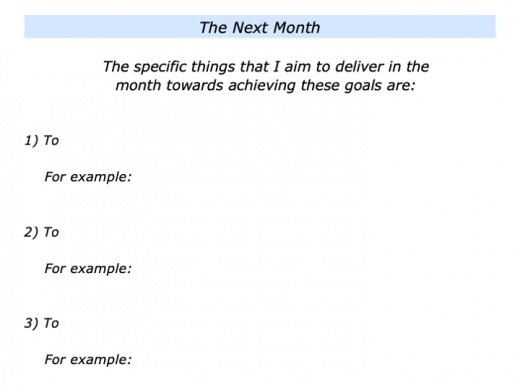

Positive teams are special. They pursue their chosen strategies, perform superb work and work towards achieving their picture of success. They also communicate the progress the whole team is making towards achieving its goals.
Here is one approach to sharing the team’s achievements along the way. This is similar to the framework used with individuals, but you can adapt it to describe the team’s successes and plans. People can then continue to work towards achieving the picture of success.
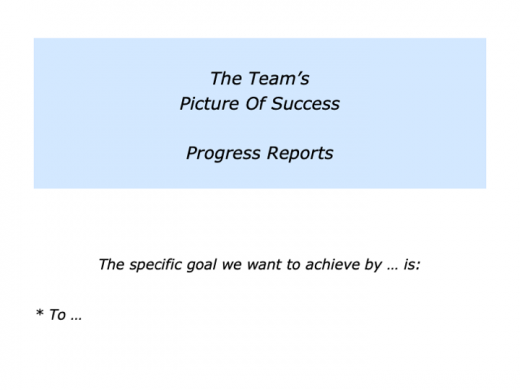
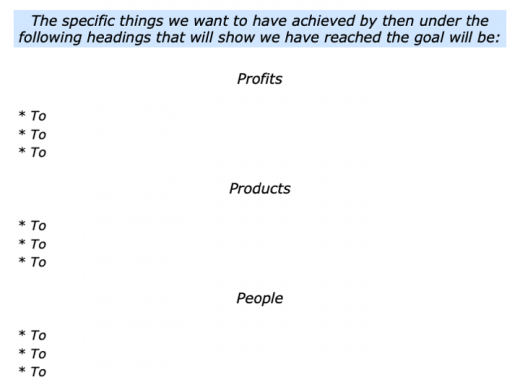
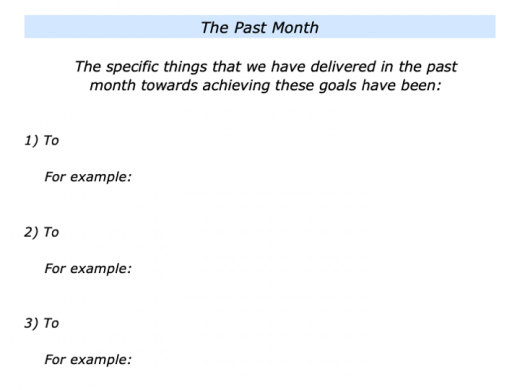
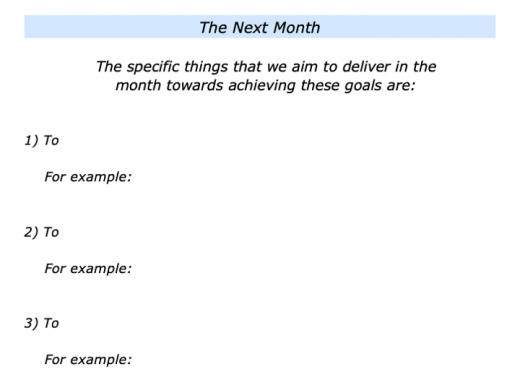
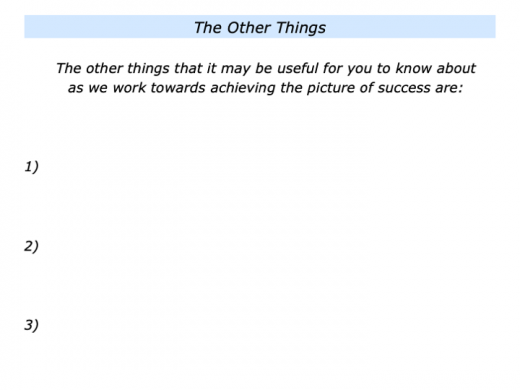
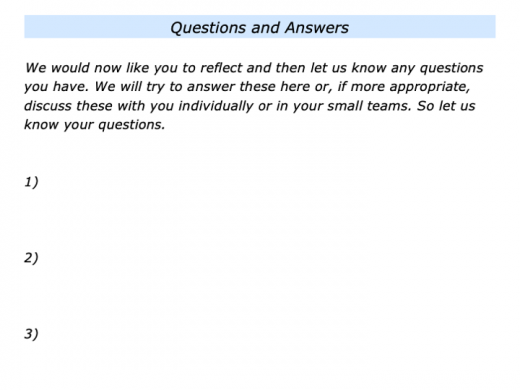
Many organisations are now made up of people who are located in different places. Let’s consider how to lead such organisations.
The Global–Local Approach
Great organisations get the right balance between the global purpose and the local practice. They combine the best aspects of a big organisation with the spirit of a small enterprise. They also manage by outcomes rather than by tasks.
The centre communicates the purpose and the principles. The way that people practice these is up to them, within parameters, in their part of the organisation. But this comes with a proviso: people must show how what they are doing is following the principles and contributing to the purpose.
Good leaders encourage people to think global and act local. This calls for creating an adult-adult relationship, however, with everybody taking responsibility for making their best contributions to the company.
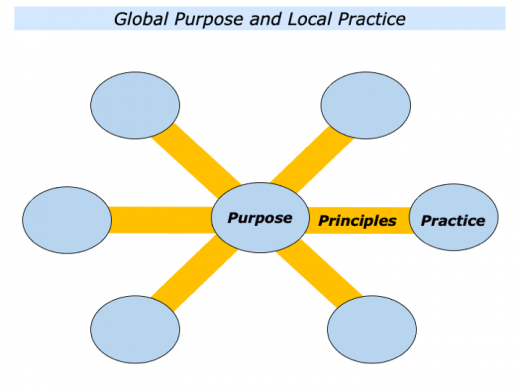
Imagine that you lead a large organisation and are addressing all the employees. You will aim to communicate the big picture whilst also encouraging people to take ownership for the local practice.
Different leaders will do this in different ways. One approach is to say something along the following lines to explain this approach to people. This covers some of the topics mentioned earlier regarding communicating with a team, but it also adds some important provisos.
Welcome To Today’s Session
I am going to give an overview of our organisation’s purpose and the part you can play in making this happen.
Later I will give some examples of how people have contributed to this purpose in the past and how they can contribute in the future.
But first let me give an outline of our overall approach to working together.
The Purpose
The purpose of our organisation is:
* To
The Picture Of Success
The picture of success we want to achieve in the next
year that will be an expression of our purpose is:
* To
* To
* To
The Principles
The key principles we aim to follow to pursue our
purpose and achieve the picture of success are:
* To
* To
* To
The Practice
The way you practice these principles will – within parameters – be up to you in your part of the organisation.
But there is a key point. You must show how what you practice supports the principles and contributes toward achieving the purpose.
We want you to take time to reflect and decide if you want to contribute. If so, we will then make clear contracts with you about the outcomes you want to deliver towards achieving the picture of success.
Good leaders build on the people who want to contribute. They then take the following step.
Managing By Outcomes
Good leaders give people the big picture because they recognise that knowledge workers, for example, want context. They then manage by outcomes rather than by tasks.
They spend a lot of time with people agreeing on what must be delivered. Many people are used to writing lists of tasks and talking about what they will do. It can take time to educate them to focus on the outcomes they will deliver.
Good leaders make crystal-clear contracts about the real results to achieve. Why? Because from then on virtually every performance conversation will start by concentrating on the agreed outcomes, rather than get into supervising the tasks.
After such a contracting session, for example, here is how one team leader might describe their contribution under the Three Ps.
My Contribution To
The Picture of Success
Profitability
To ensure my team achieves its financial targets – a profit of £500k.
To develop 3 new customers and do work with them that delivers a profit of £100k.
To reduce our overheads by £100k.
Products
To ensure more than 90%+ of our customers say they are extremely satisfied with our work.
To develop 2 new products and pilot these successfully with customers – then launch these products by the end of the year.
To simplify 2 of our complex products to ensure these are more user friendly for customers – then get a further £100k’s worth of orders for these before the end of the year.
People
To deliver an internal morale rating of 90%+ of our team members saying they enjoy coming to work each day.
To educate, equip and enable 2 of my team members to win promotion and move on to other roles in the company.
To recruit 4 new positive team members who take responsibility, build on their strengths and get some early successes that contribute towards achieving the team’s goals.
Why take this approach? People can get into a pattern of talking about details, making excuses or whatever. They may also confuse activity with results.
Certainly sometimes it is vital to revisit the aims to ensure these are still desirable and possible. Whether it concerns profits, product quality or people, however, the mantra is:
“Let’s focus on the desired outcomes. How can we do our best to deliver these results?”
Sounds tough? Perhaps, but it is also a good way of leading a team. People learn:
To clarify the specific goals that are written in outcome terms;
To make clear contracts about the goals, including the required support;
To take responsibility, be creative and do their best to deliver the agreed outcomes.
Managing By Outcomes –
The Rule Of Three Approach
There are many ways to encourage people to focus on the outcomes to achieve. One of the simplest is the rule of three approach.
This involves communicating the three goals to achieve. If appropriate, each of these can be broken down into three sub goals. You can then aim to bring these to life with specific examples.
Here are some of guidelines it can be useful to follow when taking this approach.
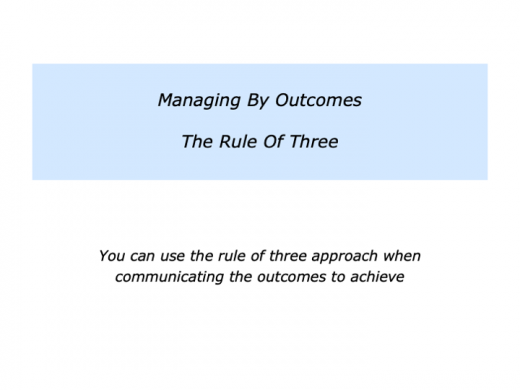
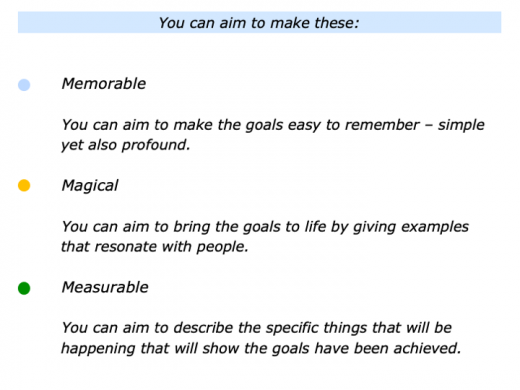
Managing By Outcomes
In Challenging Situations
Good leaders also focus on outcomes when people face challenges in their work. One leader I worked with took this approach when a team member asked them about how to deal with a problem client. The team member explained this in the following way.
“We are having problems with a difficult client. They are always complaining, even though we give good service, and this is wearing down our staff. The client is part of a culture where the bosses rule by fear, which may be why they take the same approach with us.
“The client now wants us to lower our prices. This will be difficult, however, because we make little money from our work with them. I also fear for our staff who are near breaking point. I would be grateful for any ideas you have about what we can do.”
The leader listened to their team member. They then said something along the following lines.
“Thanks for the background information. Of course, I am happy to offer some ideas. Before then, however, let’s look at the outcomes we want to achieve. Do we want:
“To keep the client – at least until we have found another to replace them; to keep giving good service and make some profit; to care for our staff and encourage them whilst we are trying to replace the client?
“Are there any other things we want to achieve? Bearing these things in mind, let’s explore the key things we can do to achieve these outcomes.”
The leader and team member agreed on a plan: a) to continue to give good service to the existing client; b) to find a new client to replace the income stream; c) to give support to their staff in the meantime. They translated their plans into action and resolved the issue within two months.
Many leaders find that over the years their control needs get stronger. They also realise, however, that they will be judged by the performance of their people.
How to square this circle? One approach is for them to manage by outcomes rather than by tasks. Taking this step can encourage and enable people to become more self-managing and deliver success. It also plays a key role in building positive teams.











































































